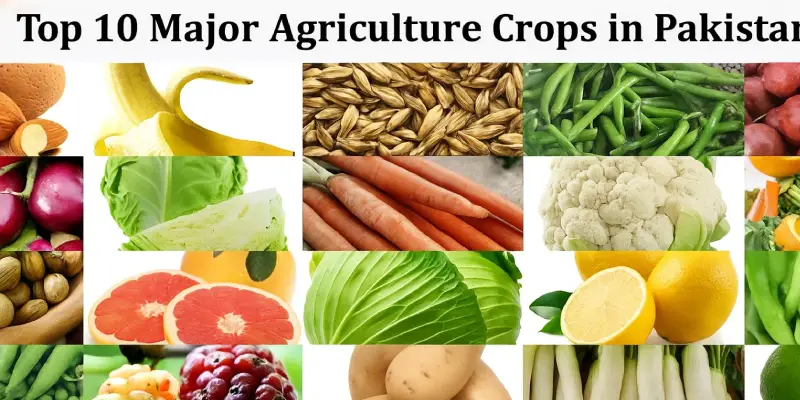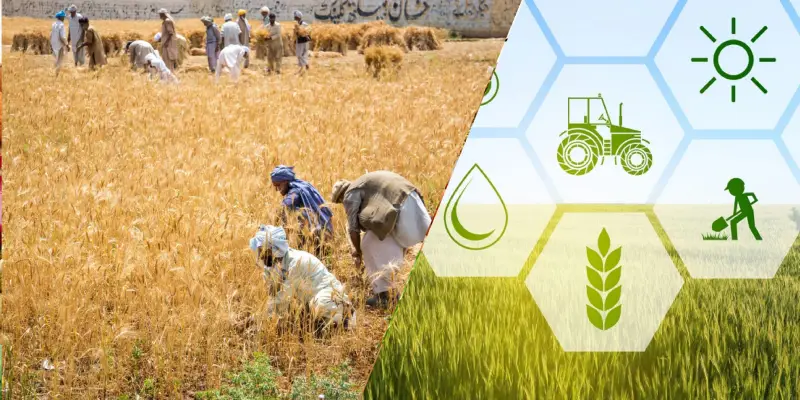Agriculture is the backbone of Pakistan’s economy. It makes up about 20% of the national GDP and gives work to nearly 40% of the people. With fertile land, different climates, and one of the largest irrigation systems in the world, Pakistan has always been a strong agricultural country in South Asia.
In 2025, the role of agriculture is still as important as ever. It provides food for the nation, supports exports, and keeps industries running. From everyday grains like wheat and rice to cash crops such as cotton and sugarcane, farming remains the lifeline for rural families and a big part of Pakistan’s trade.
This information takes a closer look at the top 10 major agriculture crops in Pakistan in 2025, their importance, the regions where they grow, the challenges farmers face, and how they shape the country’s economy.
Table of Contents
ToggleOverview of Top 10 Major Agriculture Crops in Pakistan
Agriculture is the backbone of Pakistan’s economy, providing food, raw materials, and jobs for millions of people. With fertile plains, a wide irrigation network, and diverse climates, the country remains one of the top farming nations in South Asia.
Agricultural Zones
Punjab is the main food producing province, leading in wheat, rice, and sugarcane. Sindh grows rice, cotton, and fruits like mangoes and bananas.
Khyber Pakhtunkhwa (KPK) produces maize, tobacco, and stone fruits, while Balochistan is famous for apples, grapes, and dates. Together, these regions make up the foundation of top 10 major agriculture crops in Pakistan.
Irrigation System
The sector depends heavily on the Indus River. The Indus Basin Irrigation System, one of the largest in the world, makes year-round farming possible, even in dry regions. However, mismanagement and water shortages are growing concerns.
Cropping Seasons
Pakistan follows two main seasons: Rabi and Kharif. Rabi crops include wheat, barley, and pulses, while Kharif crops include rice, cotton, maize, sugarcane, and vegetables. These seasonal cycles ensure a steady supply of food and cash crops.
Challenges
Despite being rich in resources, farmers face hurdles like water scarcity, outdated methods, and climate change. Floods and droughts also damage yields. For sustainable growth, investment in modern technology and better water management is essential.
In short, the strength of Pakistan’s economy is tied closely to farming. Understanding the top 10 major agriculture crops in Pakistan helps highlight their role in food security, exports, and rural livelihoods.
Top 10 Major Agriculture Crops in Pakistan (2025 Update)

1. Wheat The Lifeline of Pakistan
Wheat remains the most widely grown crop and the top food staple for Pakistanis. Every household consumes wheat daily, mostly in the form of roti and naan.
-
Cultivation Areas: Punjab dominates wheat production (Multan, Faisalabad, Sargodha, Bahawalpur), followed by Sindh, KPK, and Balochistan.
-
Season: A Rabi crop, sown in winter (Nov and Dec) and harvested in spring (April and May).
-
Contribution: Provides 60% of calorie intake to the population.
2025 Update on Wheat
Government subsidies on fertilizers and high yield seed varieties are expected to boost production in 2025. Pakistan is also working on climate resilient wheat strains to tackle rising temperatures and water shortages.
Wheat holds the first spot in the Top 10 major agriculture crops in Pakistan 2025 because of its role in food security.
2. Rice Pakistan’s Export Hero
Rice is the second most important cereal crop in Pakistan and plays a huge role in exports.
-
Types: Basmati rice (long grain aromatic) and IRRI rice (non aromatic).
-
Regions: Punjab (Sheikhupura, Gujranwala, Hafizabad, Sialkot), Sindh (Larkana, Badin).
-
Global Ranking: Pakistan is the 4th largest rice exporter worldwide.
Uses and Importance
Rice contributes significantly to Pakistan’s foreign exchange earnings. It is also consumed domestically, especially in Sindh and KPK.
2025 Outlook
Basmati rice continues to dominate export markets like Europe and the Middle East. To maintain quality, Pakistan is focusing on mechanized harvesting and better storage.
Rice is one of the Top 10 major agriculture crops in Pakistan 2025, and its export value makes it globally recognized.
3. Cotton The White Gold
Cotton is Pakistan’s leading cash crop and the backbone of the textile industry. Known as “white gold,” it supports the largest industrial sector of the country.
-
Major Regions: Punjab (Bahawalpur, Multan, Rahim Yar Khan), Sindh (Hyderabad, Nawabshah).
-
Uses: Textile manufacturing, seed oil production, and cottonseed cake for animal feed.
-
Contribution: Accounts for 60% of Pakistan’s export revenue through textiles.
Challenges in Cotton Farming
Cotton farmers face pest attacks like bollworm, water shortages, and rising production costs. However, the adoption of BT cotton varieties and government initiatives in 2025 aim to restore production levels.
Cotton plays a huge role in the Top 10 major agriculture crops in Pakistan 2025, especially in boosting export earnings.
4. Sugarcane A Sweet Industry Backbone
Sugarcane is a high value crop with multiple uses. It fuels Pakistan’s sugar mills and supports industries such as ethanol and jaggery (gur) production.
-
Regions: Punjab (Sargodha, Faisalabad, Multan), Sindh (Thatta, Nawabshah), KPK (Mardan, Charsadda).
-
Byproducts: Sugar, ethanol, molasses, paper, chipboard.
-
Employment: Provides jobs to thousands in rural areas and sugar mills.
2025 Update
With rising demand for ethanol and renewable energy, sugarcane is gaining importance beyond sugar production.
Sugarcane’s growing industrial demand secures its place among the Top 10 major agriculture crops in Pakistan 2025.
5. Maize (Corn) The Fastest Growing Crop
Maize has shifted from a minor crop to one of Pakistan’s fastest-growing crops.
-
Regions: Punjab (Okara, Sahiwal, Kasur), KPK (Swat, Mardan).
-
Uses: Human food, poultry feed, edible oil, starch.
-
Production Growth: Tripled in the past 20 years due to hybrid seeds.
Importance in 2025
The poultry industry is the largest consumer of maize. Hybrid maize adoption has boosted yields, making it a strong competitor among staple crops.
Maize has emerged as a key player in the Top 10 major agriculture crops in Pakistan 2025, driven by demand in poultry and livestock industries.
6. Barley A Resilient Traditional Crop
Though not as dominant as wheat, barley holds significance for rural communities.
-
Regions: Balochistan, northern Punjab, Sindh.
-
Uses: Animal feed, brewing, medicinal products.
-
Strength: Grows in dry areas with limited irrigation.
2025 Update
With the rise of health foods and pharmaceutical demand, barley cultivation is expected to increase.
Barley maintains its importance in the Top 10 major agriculture crops in Pakistan 2025 due to its resilience and diverse uses.
7. Pulses The Protein Source of the Nation
Pulses like mung, masoor, mash, and chickpeas (chana) are crucial for nutrition.
-
Production Areas: Punjab (Thal region for chickpeas), Sindh, KPK.
-
Nutritional Value: Rich in protein, affordable for low-income groups.
-
Trade: Pakistan imports pulses due to insufficient local production.
2025 Trends
Government is encouraging domestic pulse farming to reduce reliance on imports.
Pulses remain vital in the Top 10 major agriculture crops in Pakistan 2025, supporting protein intake across households.
8. Fruits Mangoes, Oranges, Bananas, and Apples
Pakistan is world famous for its fruit production, especially mangoes and citrus.
-
Mango Belt: Multan, Rahim Yar Khan, Bahawalpur.
-
Citrus Hub: Sargodha produces the world-renowned kinnow oranges.
-
Other Fruits: Apples (Balochistan), bananas (Sindh), apricots (Gilgit Baltistan).
2025 Export Outlook
Mangoes and kinnow oranges remain leading export earners. Demand in the Middle East and Europe continues to rise.
Fruits like mangoes and citrus strengthen Pakistan’s agricultural identity in the Top 10 major agriculture crops in Pakistan 2025.
9. Vegetables Daily Essentials for Every Home
Vegetables like potatoes, onions, tomatoes, and okra are widely cultivated.
-
Regions: Potatoes (Okara, Sahiwal), onions (Hyderabad, Sindh), tomatoes (Balochistan).
-
Importance: Integral to diets and local economies.
-
Market Trend: Rising demand for organic vegetables in cities.
2025 Insights
Farmers are shifting toward greenhouse farming to meet urban demand for fresh, organic vegetables.
10. Oilseeds Reducing Dependence on Imports
Pakistan spends billions on importing edible oil. To reduce this, crops like sunflower, mustard, and canola are promoted.
-
Regions: Punjab and Sindh.
-
Uses: Cooking oil, margarine, animal feed.
-
Challenge: Still imports 70% of oil needs.
2025 Update
Government policies are encouraging sunflower and canola cultivation to reduce import dependence.
Oilseeds secure their place in the Top 10 major agriculture crops in Pakistan 2025, as Pakistan works toward self reliance in edible oils.
Comparison Table of Top 10 Major Agriculture Crops in Pakistan (2025)
| Crop | Season | Main Regions | Key Uses | 2025 Importance |
|---|---|---|---|---|
| Wheat | Rabi | Punjab, Sindh | Staple food | Food security backbone |
| Rice | Kharif | Punjab, Sindh | Export & food | Major export crop |
| Cotton | Kharif | Punjab, Sindh | Textile | White gold of Pakistan |
| Sugarcane | Kharif | Punjab, Sindh, KPK | Sugar & ethanol | Industrial backbone |
| Maize | Both | Punjab, KPK | Food & feed | Fastest growing crop |
| Barley | Rabi | Balochistan, Punjab | Feed & medicine | Drought-resistant |
| Pulses | Both | Punjab, Sindh | Protein source | Nutritional need |
| Fruits | Both | Punjab, Sindh, GB | Export & food | Mangoes & kinnow |
| Vegetables | Both | Punjab, Sindh, Balochistan | Daily diet | Organic demand |
| Oilseeds | Kharif | Punjab, Sindh | Cooking oil | Reducing imports |
Contribution of Major Agriculture Crops to Pakistan’s Economy
Agriculture plays a vital role in Pakistan’s economy, contributing nearly 20% to the GDP and employing around 40% of the workforce. Much of this comes from the major agriculture crops in Pakistan, which not only feed the population but also drive exports and industry.
GDP and Jobs
Wheat, rice, sugarcane, cotton, and maize are the backbone of crop production. Wheat ensures food security, while cotton supports the textile sector Pakistan’s largest export industry.
Rice, especially basmati, is a major source of foreign exchange. Together, these crops provide jobs for millions of farmers, laborers, and workers linked to transport, mills, and storage.
Exports and Trade
Rice alone brings in more than $2 billion annually. Cotton and textiles earn even higher, making Pakistan a key global supplier. Mangoes, kinnows, and dates also add value to exports. These earnings strengthen the economy and help reduce the trade deficit.
Global Demand
The profitability of these crops depends on world demand and trade deals. Gulf countries and China are strong markets for Pakistani produce, while Europe’s strict standards push for better quality and farming practices.
The top 10 major agriculture crops in Pakistan are not just about farming they fuel industries, provide jobs, and link the country to international markets. With better policies, modern irrigation, and climate smart practices, these crops can further strengthen Pakistan’s economy.
Challenges Faced by Agriculture in 2025

Agriculture remains the backbone of Pakistan, but in 2025 it faces several pressing challenges that directly affect farmers, production, and exports. These issues not only reduce crop yields but also impact the sustainability of the top 10 major agriculture crops in Pakistan.
1. Climate Change
Unpredictable rainfall, rising temperatures, and frequent floods or droughts are disrupting the traditional cropping cycle. Farmers often face heavy losses when rains arrive late or come in excess during harvest seasons.
2. Water Scarcity
Pakistan depends heavily on the Indus River system, but water shortages are becoming more common. Poor irrigation infrastructure and wastage further reduce water availability, putting crops like wheat, rice, and sugarcane at risk.
3. Outdated Farming Techniques
Many farmers still rely on traditional methods instead of adopting modern machinery or precision agriculture. This limits productivity and makes it difficult to compete with countries using advanced technologies.
4. Rising Input Costs
Fertilizers, quality seeds, pesticides, and fuel are becoming more expensive every year. Small farmers, who make up the majority, struggle the most, as higher costs cut into already thin profit margins.
5. Global Market Competition
Pakistani exports face stiff competition from countries like India, Thailand, and Vietnam. Without quality improvements and better trade policies, crops such as basmati rice and cotton may lose their global edge.
While the top 10 major agriculture crops in Pakistan continue to sustain the economy, these challenges need urgent solutions. Investment in modern technology, efficient irrigation, and farmer support programs can help overcome the hurdles and secure Pakistan’s agricultural future.
Future of Agriculture in Pakistan (2025 & Beyond)
The future of agriculture rests heavily on the top 10 major agriculture crops in Pakistan, as they remain the backbone of food security and exports. With climate challenges rising, farmers are shifting towards smarter solutions like drip irrigation, precision farming, and even drones to improve harvests.
Government policies that support modern practices and youth driven agritech startups will be key. From mobile apps for crop guidance to digital marketplaces for exports, technology is reshaping how farmers grow and sell.
If Pakistan balances innovation with tradition, the top 10 major agriculture crops in Pakistan can drive growth, create jobs, and boost exports for years to come.
Conclusion
The top 10 major agriculture crops in Pakistan remain the foundation of the country’s economy and food system. From wheat and rice that feed millions, to cotton and sugarcane that fuel industries, these crops shape both rural livelihoods and export earnings.
Agriculture not only contributes significantly to GDP but also supports nearly half of the population through direct or indirect employment.
As we move forward, sustainable practices are vital to overcome climate change, water shortages, and rising costs of production. By adopting modern farming methods, improving irrigation, and supporting farmers with technology and better policies, Pakistan can secure its food needs and strengthen its role in global trade.
The future of farming lies in modernization, innovation, and government support, ensuring the top 10 major agriculture crops in Pakistan continue to thrive for generations.
FAQs
What is the most top 10 major agriculture crops in Pakistan in 2025?
Wheat remains the most important crop, as it is the staple food for the majority of the population.
Which crops are major exports of Pakistan?
Rice, fruits (especially mangoes and citrus), and cotton are leading agricultural exports.
How does climate change affect Pakistani agriculture?
Unpredictable rains, floods, and rising temperatures reduce crop yields and threaten food security.
What percentage of Pakistan’s population depends on farming?
Around 40% of the population relies on agriculture for their livelihood, directly or indirectly.
Which province produces the most wheat and rice?
Punjab is the leading producer of both wheat and rice, thanks to its fertile land and irrigation system.




